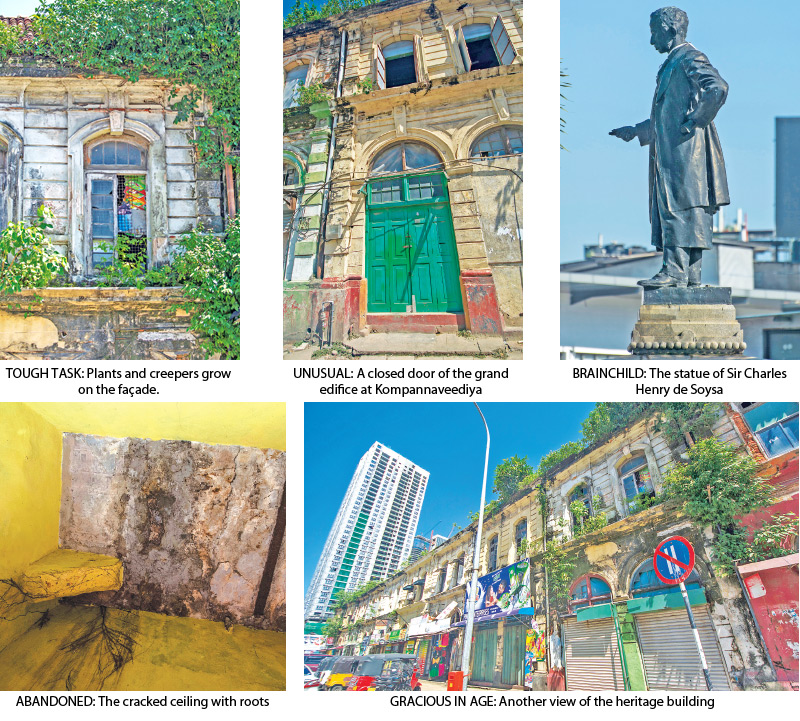
When we hear the name Kompannaveediya (Slave Island), the image of a bustling city dotted with buildings comes to mind. (The English name alludes to the dark era of the slave trade). Recently, it was reported that the de Soysa building which was part and parcel of Kompannaveediya was going to be demolished by the Urban Development Authority. Last week I hurried to the spot to view this colonial architectural marvel before it succumbs to the bulldozer.
The demolition of old buildings and the construction of modern edifices in cities is common and adds beauty to urban dwellings. But the demolition of the de Soysa building is not so easy as its roots go back to over a century.

Scratch a wall of any building in the heart of the city and it would speak volumes about the history of the bygone era. But, standing among several other contenders and acknowledged and recognized for its majestic presence is the Soysa edifice.
Constructed around 1870 with distinct Victorian renaissance architecture, the Soysa edifice stands tall opposite the Kompannaveediya Railway Station on Justice Akbar Mawatha which is the longest road frontage of any building in Sri Lanka.
If you travel in the Lipton roundabout near the Town Hall, you will catch a glimpse of a majestic dark bronze statue. It is the figure of Sir Charles Henry de Soysa (1836-1890), the 19th century entrepreneur and philanthropist who was the builder of de Soysa building in Kompannaveediya. He had a vast property network ranging from real-estate to tea and mining, and spent all his wealth for the benefit of the ordinary masses. While Colombo’s heritage structures such as the de Soysa building itself are more than a century old, they are a part of the city’s architectural identity.
The building features two-foot-thick brick walls, the beams and ceilings fashioned from Burma teak and massive granite slabs in its foundation structure. Moreover, it is said that in the past there was a corridor to access all the shops from start to end in the building, but today the entrances to the shops are from the main road. The 15-foot tall cast-iron arch frames were imported from England. As iron rusts due to the sea breeze (the sea is only around 500 metres away as the crow flies), specially made cast-iron arches had also been imported from England for the building while the window pane glass was imported from Belgium. The building seems to have been renovated from time to time by the occupants and some of the old features removed in the recent past.
The de Soysa building is a fine example of shop houses in Sri Lanka. While the ground floor was occupied by the shops, the upper floor is used as homes which could be reached by climbing the staircase from the shops. The intention of this concept was that after a hectic day’s work in the shop, the shopkeepers can spend the night upstairs leisurely.
“We heard that this building is going to be demolished. It is said that this land would be given to a foreign company to build a high-rise apartment. We don’t know when, but still it is not condemned to be demolished,” a cool drink vendor told me. “We are afraid to live here. This building would collapse anytime. See that crack on the ceiling with the roots of trees. If it is demolished, we would be happy,” says a cobbler who owns a tiny shop at the edge of the building.
Living in a heritage building costs time and money; maintaining them is no small feat – whitewashing each year, fresh plastering before each monsoon, and the perennial cleaning of the dust-filled rooms and the termite-infested woodwork. The present occupants have carried out alterations to the building by adding walls. Plants and fungus grow on the facades of the top part of the building due to lack of maintenance.
It is said that the deeds of this building are held by the descendants of the de Soysa generation. However, the de Soysa building has surprisingly survived over a century, withstanding the real estate boom of the 1990s.
Eventually, heritage buildings such as the Soysa edifice can be renovated to preserve their ancient glory and turned into tourist attractions. I feel that the demolition of such a heritage structure would be akin to the crumbling down of an archaeological monument.
